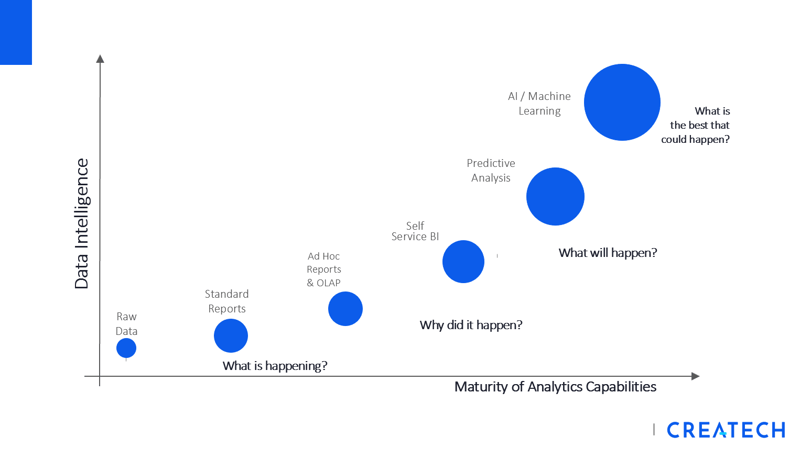Maximo Reporting, BI and Artificial Intelligence, What is the Trend?
I was asked: “How can we use Artificial Intelligence (AI) within Maximo?” It is a common Enterprise architecture question across many domain responsibilities. Many large companies are exploring this now, and executives are interested in embarking on a program. Talking with other senior technical people, they struggle to understand how it can be done reasonably, with real business cases. So, now there is a hunt for business cases with viable AI products that are currently available.
Maximo relates to IoT, Watson, and Bluemix, but the licensing models differ from traditional software licensing and are not quickly ready for use. This is also true of the licensing of other services such as cloud-based services. We need to adjust our expectations. Ideally, we start with something more concrete; a sandbox where we can try it out. IBM has a free Watson trial setup that is a good way to understand the leap forward of Artificial Intelligence.
One might ask what the difference between Business Intelligence (BI), and Artificial Intelligence (AI) is, and reporting for that matter. It turns out they are all related. We all know what reporting is, and we can consider BI as the next evolution from reporting, and AI being the evolution of BI. AI then takes it a step further. Effectively the three are evolutionary steps along the same continuum, reporting. A quick online search finds many models explaining this trend to maximize the information we already have.

Reporting
Reporting is the ability to extract data and represent it in a business-consumable format, to answer a business question. Over the last ten, twenty years, if not more, reporting has been continuously refined to include not only simple correlations and calculations but also graphical representations. The most recent reports may even include links to each other, or hyperlinks to applications. They can often be created or generated dynamically in various formats.
Business Intelligence (BI)
Business Intelligence is often referred to by its acronym BI. It takes reporting to the next level by providing the ability to correlate multiple data sources and formats for more complex analysis. Over reporting, it also commonly produces graphic analysis charts, with more capability. Some products can analyze unstructured data such as images and soundtracks or even big data (extremely large data samples).
BI can give us KPIs that combine EAM, ERP and CRM data samples for truly holistic business views and dashboards. We may need to see the number of assets that have more than doubled their costs since purchase, from foreign suppliers, over time, given a global crisis affecting borders, as a series of KPIs and related data samples.
The manufacturing industry generally uses many electric devices, and BI insights can help optimize their use and perform maintenance on the said devices before potential failures happen. BI starts to support our holy grail of reporting, predictive analysis.
Artificial Intelligence (AI)
Artificial Intelligence further enhances BI or even reporting. Rather than answering complex questions, it challenges businesses to uncover new questions they hadn’t thought of but should be asked. Machine Learning is a related capability, more commonly discussed in the maintenance industry, but still prompts companies to ask new questions and consider new business models.
AI allows us to compare our data with public data, such as weather and world news, to look for relationships we might not have thought to explore. When is the best time to service my HVAC system, given existing demands and failures? What are the interdependencies of my Preventive Maintenance program, taking into account external influences? AI helps us find new opportunities to repair or advance our business.
AI depends even more on large amounts of data, and correlation algorithms. Each of these (BI and AI) extend the other, often working in tandem. AI is more of a hidden analysis capability with results shown within BI or reporting content.
Maximo Reporting, BI and AI Options
Maximo comes with a reporting tool BIRT, with modern enterprise-level reporting capability. This capability can extend to a more powerful Cognos BI dashboard, the Internet of Things, and advanced artificial intelligence tools based on IBM’s Watson and Bluemix.
If we embark to expanding into BI tools, we do not generally replace all Reports within the BI tool, nor would AI replace all existing BI content. Some reports are still of benefit as simple reports. BI dashboards provide live efficient business views. These capabilities generally overlap organically as business benefit becomes clear.
Do I need Artificial Intelligence (AI)?
Artificial Intelligence is a philosophical IT concept, hot in academic circles for 40 years or more now. Since Alan Turing invented the Turing Machine, computers keep shrinking as they become more powerful and pervasive. The films in the Terminator series, or any other similar sci-fi movie, make us increasingly wonder whether computers will one day supersede humans in terms of intelligence.
But first, you should ask: “What is intelligence?” This becomes a philosophical question as much as an IT question. Mark Zuckerberg and Elon Musk differ on where this will or should go, countering on the fear-based half of the question. The academic world differs on what artificial intelligence is or should be.
I read a book written on the subject, “On Intelligence” by Jeff Hawkins, and would rather not make an attempt at defining the term. From our perspective, AI is the computer system’s ability to tackle complex questions, enhance our thinking, correlate unstructured information, and possibly ask questions not yet perceived. It allows us to analyze outside the box and maybe predict. There is a wealth of discussion out there on the topic.
Certainly, intelligence is all about knowing what questions to ask and when. Once I have that, I can ask my IT guys to build the report, a KPI, a BI dashboard or buy a new software tool. Why would I want to keep upgrading my reporting tool when BIRT can generate all the reports I need? Simple: do I build my reports once and never change them or never create new reports?

We write reports to uncover business information. After several iterations, we often have new questions. We often need to correlate the report information with something new and often do it outside our reporting tool. It is rarely a static question. We can see each of these steps, from BIRT to Cognos, and from Cognos to AI as a company’s operational maturity evolves equally to its ability to extract data that can be useful to answer operational questions. BI and AI simply ten-folds our reporting capabilities.
If AI has been around for 40 years, why is it so out of reach? It is most probably more within our reach than we can imagine. Early AI type products were called Expert systems. They were used in medicine for diagnosis and in law, for example, to correlate and locate relevant information amongst large differing data sources. AI later became available as well-known products such as Siri and Alexa.
As discussed above, AI is available to businesses through various services and products, for a different use than that to which companies are accustomed. It is happening, and all most businesses need is a plan and supporting business cases. We must recognize that the answer to some operational questions requires only a report, others may require an operational intelligence system, while few questions justify the use of artificial intelligence. Even once I have an AI program in place, I will likely still be creating some new reports, and adapting BI dashboards. Some business questions are well known, and do not go away.
Conclusion
So, when should we embark on this path leading us to Artificial Intelligence? The answer is now. How? By validating the quality of existing data and working to make the best use of existing reporting tools. In time we’ll find that we need more than only reporting capabilities on specific topics. We naturally mature into the next step, a BI tool such as Cognos. Again, with time, and on a subset of topics, we mature into AI tools such as Watson and Bluemix. Each step adding to our capabilities.
These evolutionary steps are more about introspection and market business analysis than about the software or services. I believe that the evolution of capabilities will never cease, creating a yet unsuspected capacity for operational decision-making, parallelled with companies’ efforts to improve continuously.






